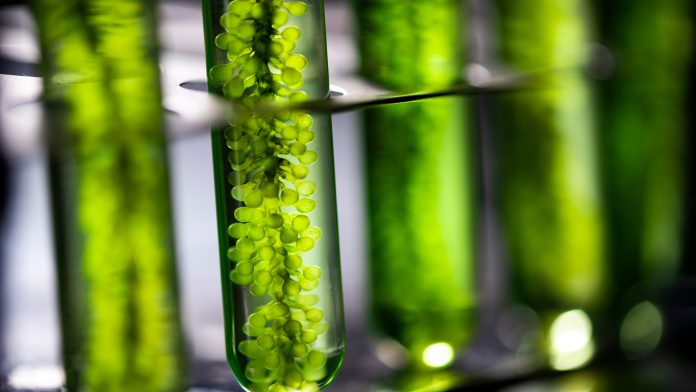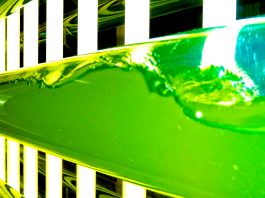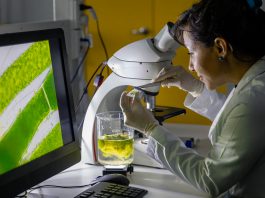Robert Roulston, CEO of Industrial Plankton, presents the company’s live feed equipment for efficient zooplankton and algae production.
Reliably producing enough high-quality live feed is the bottleneck for many shellfish, shrimp, and marine finfish hatcheries. The feed must be highly nutritious and low in pathogens. Without enough feed, animals starve or are underfed. Most hatchery operators calculate the cost of this loss and weigh it against the live feed’s cost of zooplankton and algae production.
The cost of poor-quality live feeds is often overlooked. Both algae and zooplankton cultures are common vectors for pathogens. Even when not noticeably affecting mortality rate, hatchery animals that survive early infections often have a worse feed conversion ratio (FCR) and lower growth rate in the hatchery. But the real cost of poor-quality live feeds to the entire production chain is the effect on growth rate and FCR in the grow-out.
To help solve the problems with reliable production and feed quality, Industrial Plankton produces live feed equipment for culturing algae and zooplankton, with a focus on maintaining a stable biosecure culture environment.
Algae
Consistent on-site algae production can be time consuming and unreliable. By maintaining a clean, stable culture environment and automating many routine functions, Industrial Plankton photobioreactors (PBR#) ensure consistent algae production to meet hatchery needs (see Fig. 1).
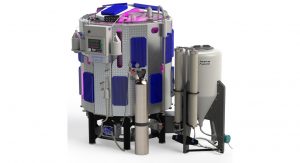
Biosecurity
A big challenge to producing clean algae outside a lab is biosecurity. Grazers or pathogenic bacteria can invade a culture and establish a population, causing reduced productivity or larval mortality. To establish a clean culture environment, the PBR 1250L uses an automated clean-in-place (CIP) system to clean and disinfect the tank before starting a new culture. Additionally, the PBR uses micron filters to maintain biosecurity while adding the water, nutrients, air, and CO2. To start a new culture, the inoculum is connected to the PBR with sterile disconnects, then pumped in with a biosecure pump. By maintaining biosecurity, a PBR can continuously produce clean, high-quality algae for months.
Reliability through automation
After inoculation, the next step is providing the right temperature and amount of nutrients, CO2, and light needed to sustain production and prevent culture crashes. To minimise time and effort, the PBR automates these functions. Nutrients are stirred and added automatically, and closed loop pH control adds CO2 as the algae grows, maintaining constant pH and preventing carbon limitation. Harvesting is done with the push of a button, scheduled to harvest automatically, or set to harvest continuously. Temperature is controlled using a chiller and an internal heat exchanger. As long as the PBR has a supply of water, CO2, and nutrients, it can produce algae automatically.
A touchscreen control makes it easy to adjust settings. The controls also log and graph the sensor data, simplifying troubleshooting and identifying problems before they impact production (see Fig. 2).
Cleaning
An unreliable and labour-intensive task required when culturing algae is cleaning tanks. Using a self-cleaning biosecure tank, algae cultures can grow productively for longer. When a tank needs to be cleaned, the PBR’s automatic cleaning system removes the need for manual cleaning, working like a dishwasher to pressure wash the inside of the tank.
Floorspace
Compared to traditional cultures, a high-density bioreactor requires only a fraction of the floorspace, allowing facilities to increase their output without increasing floorspace, or saving new facilities construction costs by reducing space requirements.
Cell density
When culturing algae, it is important to quantify algae biomass, but counting algae cells on a microscope is time consuming and requires technical skills. To reduce the need for manual cell counts, the PBR 1250L uses a density sensor to output a linearised 0-10 value (see Fig. 2, in green). Real-time density feedback helps operators maximize productivity by seeing the effect of changing light, nutrient additions, harvest rate, etc.
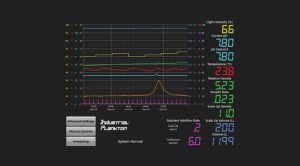
Rotifers
Rotifers are a critical first food for many larval fish but are labour intensive to produce and are a common source of Vibrio and other pathogens.
Biosecurity
Most rotifer production is still done in batch systems. The problem with batch production is lack of control over the bacterial population. Vibro is often present in rotifer cultures or introduced with incoming water, so operators are often scaling up a batch of Vibrio along with the batch of rotifers.
In a stable environment without excess organic waste, pathogenic bacteria can be kept in check. If system parameters are unstable, the fluctuating organic load can allow faster-growing pathogenic bacteria to rapidly increase in numbers. In a stable system, the bacterial population becomes dominated by beneficial heterotrophic bacteria.
The constant removal of organic waste from the culture is also critical since high levels of organic waste generally encourages growth of opportunistic bacteria.
Reliability through automation
To reduce levels of pathogens in the culture, the Industrial Plankton Rotifer System (see Fig. 3) operates as a continuously recirculating system with an attached biofilter. This provides a stable culture environment rich in beneficial bacteria, preventing opportunistic pathogenic bacteria from proliferating.
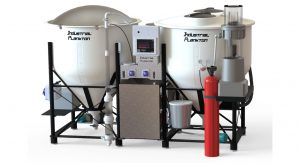
The rotifer system uses a touchscreen interface to display and log data and to control vital parameters such as temperature, pH, and dissolved oxygen. To maintain good water quality, organic waste is removed using a self-cleaning mechanical filter, a foam fractionator, and finally a biofilter to detoxify ammonia.
Summary
Reliable production of high-quality live feed in a stable biosecure culture environment allows for improved nutrition and lower chances of early infections in animals, resulting in higher hatchery survival and growth rates, and better FCR in grow-outs. Compared to traditional cultures, high-density cultures require only a fraction of the floorspace, increasing hatchery output without increasing the space required for live feeds.
Industrial Plankton’s equipment is currently operating in 19 countries to support the hatchery production of oysters, mussels, clams, vannamei shrimp, monodon shrimp, and marine finfish.
Please note, this article will also appear in the sixth edition of our quarterly publication.

